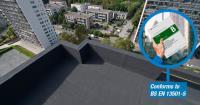 Add My Company
Add My Company
Sign In
UPDATED BAN ON COMBUSTIBLE MATERIALS
07-02-2022

Regulation 7, which deals with the government ban on combustible materials as part of the external wall in ‘relevant buildings’ (i.e. buildings containing one or more dwellings or an institution, such as student accommodation, care homes, sheltered housing or hospitals, over 18 metres or 7 storeys above ground level) was incorporated in Approved Document B in 2018, resulting in Requirement B4. This led to the introduction of the term ‘specified attachment’ … and to some confusion in the industry. Now, a common understanding has been reached that is in line with the new BS8579 ‘Guide to the Design of Balconies and Terraces’.
THE DEFINITION OF A BALCONY
When Regulation 7 included ‘specified attachments’ in the ban of combustible materials along with parts of an external wall – i.e. balconies attached to an external wall – confusion arose over what exactly constitutes a balcony. Since then, the NHBC and the flat roofing industry have come to agree that, for the purpose of Approved Document B, balconies are not deemed roofs. The elements considered to fall within the definition of a ‘specified attachment’ are:
- inset/internal/recessed balconies
- projecting/external balcony
- access balconies
- enclosed balconies (such as winter gardens) and inset terraces
For such ‘specified attachments’ to relevant buildings, Regulation 7(2) requires that non-combustible materials be used. However, the waterproofing membrane forms an exception, so a typical waterproofing membrane can be used on balconies. Access terraces, roofs, floors and podiums are not considered ‘specified attachments’.
BS8579 states that ‘components of balconies including the supporting structure in a free-standing balcony on all buildings with an occupied floor over 11 metres above the lowest ground level and all buildings with stacked balconies, regardless the level of the highest occupied floor, should be constructed from materials achieving class A1 or A2-s1, d0, in accordance with BS EN 13501-1:2018’.
WHEN IS A WALL A ROOF?
Another area of confusion related to the question: when is a wall a roof? This regards the point where the flat roof waterproofing abuts a perimeter or roof penetration and is traditionally dressed a minimum of 150 millimetres above the finished roof level or walking surface. The definition of a roof is 0-70 degrees (a larger slope would constitute a wall), yet Regulation 7(3) excludes any part of a roof connected to an external wall. The part of the roof dressed up the wall was exempt but with no clarification on the maximum height. Now there are guidelines in place about the insulation used at these points.
It is often required to provide a thermal break at the point where a roof, balcony or terrace abuts an external wall. Combustible thermal breaks are acceptable in some cases:
- when the abutment is not against a habited space.
- for the area up to 150 millimetres above the finished roof level or walking surface combustible insulation is allowed providing the thermal break does not span across a compartment line and is no thicker than 60 millimetres, which is considered sufficient thickness for a thermal break in compliance with Part L.
For heights exceeding these measurements, non-combustible insulation is recommended and typically limited to approximately 1,100 millimetres for parapets as well as lift and stair overruns. A parapet wall is an extension of an external wall and subject to Regulation 7(2). This includes the ‘reverse’ side of the parapet wall. Likewise, lift and stair overruns are regarded as external walls and need to comply with Regulation 7(2).
For more information on UPDATED BAN ON COMBUSTIBLE MATERIALS talk to SOPREMA UK
Enquire Now
List your company on FindTheNeedle.
